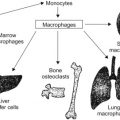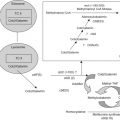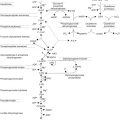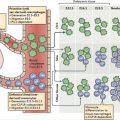Abstract
Hematopoietic stem cell transplantation (HSCT) has become an accepted therapeutic modality for the treatment of malignant and nonmalignant disorders. The indications for allogeneic and autologous HSCT are shown. Most allogeneic transplants performed in patients <20 years old are for acute leukemias (43%) or nonmalignant indications (35%). Preparation, or “conditioning,” for HSCT involves the delivery of high-dose chemotherapy with or without radiation to ablate or reduce hematopoiesis and to provide sufficient immunosuppression to allow donor cell engraftment.
Keywords
Human leukocyte antigen, high-dose chemotherapy, GVHD, NHL
Hematopoietic stem cell transplantation (HSCT) has become an accepted therapeutic modality for the treatment of malignant and nonmalignant disorders. Tables 31.1 and 31.2 list the indications for allogeneic and autologous HSCT. Most allogeneic transplants performed in patients <20 years old are for acute leukemias (43%) or nonmalignant indications (35%). Preparation, or “conditioning,” for HSCT involves the delivery of high-dose chemotherapy (HDC) with or without radiation to ablate or reduce hematopoiesis and to provide sufficient immunosuppression to allow donor cell engraftment.
| MALIGNANT DISORDERS |
| This group includes patients under 21 years of age with any of the following: |
|
| NON-MALIGNANT DISORDERS |
|
a The high-risk group as defined represents approximately 30% of patients and has a predicted overall survival (OS) <35%. This group additionally, may include non-low risk cytogenetics with positive (≥ 0.1%) positive minimal residual disease (MRD) at the end of Induction I[low risk cytogenetics is defined as inc(16)/t(16;16) or (8;21) cytogenetics or NPM or CEBPα mutations].This group of patients should optimally receive HSCT, if possible, after Intensification I.
b Investigators differ regarding the optimum treatment and may consider HSCT for ALL in CR1 for: Ph+ ALL with available HLA matched sibling; MLL rearrangement with slow early response [defined as having M2 (5–25% blasts) or M3 (>25% blasts on bone marrow examination on Day 14 of induction therapy)]; intrachromosomal amplification of chromosome 21(iAMP21); Early T-cell precursor (ETP)-ALL, ALL with positive > or =0.01% MRD especially at the end of consolidation.
c Unstable phase as defined with longitudinal Q RT-PCR for BCR-ABL in response to tyrosine kinase inhibitors (TKIs) treatment; unlike adults, in children, investigators differ regarding the optimum treatment and may consider HSCT, if optimal, donor is available, regardless of the response to TKIs treatment.
d Indications for HSCT using unrelated donor (or cord blood) in WAS include; age ≤5 years old, refractory or symptomatic transfusion dependent thrombocytopenia, severe auto-immune manifestations not controlled on medical therapy, life-threatening or recurrent serious infections in the past requiring hospital admissions, while on standard prophylaxis.
e Indications for HSCT in sickle cell disease (SCD) may include history of one or more of the following: Recurrent vaso-occlusive crisis requiring hospitalizations or emergency room visits and narcotic use to control pain; evidence of SCD ischemia or pathology by cerebral magnetic resonance imaging (MRI) or cerebral magnetic resonance angiography (MRA) scan; history of elevated trans-cranial flow Doppler studies; recurrent acute chest syndrome, sickle nephropathy; Grade ≥1 avascular necrosis of 1≥ joint(s); red-cell alloimmunization during transfusion therapy interfering with the ability to use transfusion therapy.
f Reduced intensity conditioning used due to poor tolerance to chemotherapy.
g G-CSF may be successful in treatment and avoiding HSCT. Requiring GCSF therapy ≥10 ug/kg/day or marrow failure resulting in pancytopenia requiring transfusions are clear indications to consider HSCT from any suitable unrelated donor or cord blood.
h Transfusion dependance or intolerance to steroids are clear indications to consider HSCT from any suitable unrelated donor or cord blood.
i HSCT provides a population of cells with the capacity to produce the missing enzyme. Early transplantation is the goal so that enzyme replacement may occur before extensive central nervous system injury becomes evident.
| HEMATOLOGIC MALIGNANCIES |
| SOLID TUMORS |
a Relapsed or refractory disease but achieved at least partial response with conventional chemotherapy (i.e., chemosensitive disease).
b Metastatic disease at presentation but achieved partial remission with conventional chemotherapy or relapsed but has chemosensitive disease.
The rationale for HDC involves the theory of the steep dose–response curve for many chemotherapeutic agents. Most drugs exhibit a log-linear relationship between tumor cell kill and dose over a certain range, followed by flattening of the curve in the upper dose ranges. For this reason, small changes in dose can produce a significant change in response to chemotherapeutic agents. For many chemotherapeutic agents, the major dose-limiting toxicity is myelosuppression. Sufficiently high doses of chemotherapy cannot be delivered out of concern for permanent damage to the hematopoietic system. While hematopoietic growth factor support offers the potential to maximize the dose–response of standard-dose chemotherapy, allogeneic HSCT or autologous hematopoietic stem cell (HSC) rescue offer the opportunity to exceed marrow tolerance. This permits the delivery of a higher dose of chemotherapeutic agents, thus achieving a higher peak on the tumor-kill versus drug dose curve. A 3- to 10-fold increase in drug dose may result in a multiple log increase in tumor cell killing. Generally, multiple drugs are used for the conditioning regimen in order to overcome tumor heterogeneity and drug resistance.
The most common type of HSCT to treat hematological malignancies and nonmalignant disorders is allogeneic, using a human leukocyte antigen (HLA)-matched histocompatible donor. Solid tumors have been treated with HDC followed by autologous HSC rescue with the concomitant use of hematopoietic growth factors such as granulocyte colony-stimulating factor (G-CSF) to reduce the duration of neutropenia caused by escalating doses of chemotherapy.
Table 31.3 lists the different sources of HSCs used for transplantation. Tables 31.4 and 31.5 list the advantages and disadvantages of allogeneic and autologous HSCT, respectively.
|
a Ex vivo purging for removing malignant cells from peripheral blood stem cells or marrow rely upon physical (density or velocity sedimentation, filtration), pharmacologic (e.g., chemotherapy) or immunologic (monoclonal antibodies) principles.
b This is a useful method in patients who have received previous pelvic radiation therapy or because of tumor in the marrow. G-CSF 10 µg/kg/day or GM-CSF 500 mg/m 2 for 5–7 days can be used to mobilize progenitor cells. Blood progenitor cells can be collected for 2–5 days beginning on day 4 or 5 after initiation of growth factor.
| Advantages | Disadvantages |
|---|---|
|
|
a The relapse rate is 2.5 times lower in allogeneic recipients who have grade II–IV acute GVHD compared to recipients without GVHD. Leukemic cells have been reported to disappear during episodes of acute GVHD.
| Advantages | Disadvantages |
|---|---|
|
|
Allogeneic Stem Cell Transplantation
The single most important predictive factor for the outcome of an allogeneic HSCT is the degree of immunologic match between the donor and recipient. This is dependent on the degree of match between the donor and recipient major histocompatibility complex (MHC).
Histocompatibility Testing
The MHC genes are mapped within a region called HLA (human leukocyte antigen system A) located on the short arm of chromosome 6. HLA antigens are responsible for rejection of foreign objects from the body. There are six major loci—A, B, C, DR, DQ, and DP, which are divided into two groups. The class I antigens are HLA-A, HLA-B, and HLA-C and the class II antigens are HLA-DR, HLA-DQ, and HLA-DP. They are segregated by haplotype from father and mother. The class I molecules are composed of an α chain and β2 microglobulin, are highly polymorphic, and are expressed on most nucleated cells and on platelets. The HLA class II loci are involved in exogenous antigen processing. The HLA class II antigens are heterodimeric cell surface molecules formed by the α and β chains, each of which is polymorphic. HLA terminology is designated by the World Health Organization (WHO) nomenclature committee for factors of the HLA system and is updated at regular intervals.
To assess the degree of HLA compatibility, donor and recipient need to be HLA “typed.” Typing methods are serological (antigen) or molecular (allele) (with low, intermediate, or high resolution). The broadest designation of HLA type is based on serologic typing, with the highest specificity based on the actual DNA sequence.
The following different techniques have been used for the identification of class I and II types:
- •
Sequence-specific oligonucleotide probe.
- •
Sequence-specific primer.
- •
DNA sequencing (usually reserved to resolve any ambiguity that is not resolved by the above methods).
HLA matching for the purpose of HSCT is generally confined to major class I and II loci, although it is increasingly appreciated that minor histocompatibility antigens also play important roles in the outcome of allogeneic HSCT. Any disparity at major HLA loci between the donor and the recipient requires vigorous immunologic intervention to avoid rejection, or, should engraftment occur, subsequent graft-versus-host disease (GVHD).
Donor Selection
Any HLA-identical sibling, who does not have an anticipated risk for the underlying condition for which their sibling is undergoing transplant, should be considered a potential donor. ABO mismatch is not a contraindication, but if multiple donors are available, a donor with the same ABO type is preferred (major ABO mismatch (A or B or O) requires the removal of the red cells and/or plasma from the bone marrow graft prior to infusion). The HLA match can be phenotypic or genotypic. Despite the preference for a sibling donor, 70–75% of patients have no acceptable donors within their families. In these cases, volunteer unrelated donors who are HLA, A, B, C, and DR compatible or minimally mismatched with the recipients are sought through a search of the US National Marrow Donor Program and Bone Marrow Donors Worldwide.
An acceptable adult unrelated donor donating bone marrow or peripheral blood stem cells (PBSCs) should be matched via high-resolution DNA typing at least seven of eight alleles (HLA-A, B, C, and DRB1).
An acceptable umbilical cord blood (UCB) donor should be matched via low-resolution DNA typing (or serology with high-resolution DRB1 typing) at least four of six antigens (HLA-A, B, and DRB1). For double UCB donations (used as needed to overcome cell dose limitation), each should be matched to at least three of six HLA-A, B, and DRB1 antigens with the other unit, and each unit must match independently with at least four of six HLA antigens with the recipient.
Suggested Strategy for Donor Selection and Prioritization
- 1.
Priority of donor by HLA disparity for a related donor is
- a.
HLA-identical sibling.
- b.
HLA-matched relative (fully matched 10/10).
- c.
Single HLA class I antigen or single class II allele mismatched relative. The class II antigen matching must be confirmed by high-resolution molecular typing.
- a.
- 2.
The priority of donor by HLA disparity for an unrelated, volunteer donor is
- a.
HLA alleles matched at all loci, 10/10 match (A, B, C, DRB1, DQB1).
- b.
Single HLA-A or HLA-B allele mismatch, 9/10 match.
- c.
HLA alleles match at A, B, and DRB1 with a micromismatch or major mismatch at C loci (8/10 or 9/10 match).
- d.
HLA A, B allele match but one allele mismatch at DRB1, 9/10 match.
- e.
One antigen mismatch at HLA A or B in the cross-reactive group with allele match at DRB1 (high-resolution typing for all class I and class II antigens are required).
- a.
- 3.
The priority of donor for UCB units is
- a.
A 6/6 HLA-matched unit.
- b.
A unit with one minor or major mismatch at class I (5/6).
- c.
Two minor or major mismatches at class I (4/6 match) or one minor or major mismatch at class I and a micromismatch at class II (4/6 match). Recent data support the use of allele-level HLA matching in the selection of single UCB units.
- a.
Secondary Donor Prioritization (After HLA Matching Prioritization)
- 1.
HSC source . For recipients of HLA-matched related donor allografts, the preferred source of HSC, PBSC, bone marrow, or UCB, will be determined by the transplant protocol on which the recipient is enrolled, the disease status of the recipient, and/or the medical condition of the donor. Bone marrow is the preferred source for most allogeneic pediatric transplants. This is discussed in more detail below.
- 2.
Cell dose . When using bone marrow or peripheral blood as the HSC source, the donor’s size must be adequate to allow safe donation of the requested cell dose. This is more likely to be a consideration when the recipient is large-sized or in circumstances where bone marrow harvest is the preferred source of graft. While the cell dose is generally controllable when bone marrow or peripheral blood is the HSC source, UCB units have fixed cell doses.
- 3.
Donor gender (male preferred).
- 4.
Donor age group . The younger donor is preferred unless the donor’s size would prohibit collection of sufficient cells for transplantation.
- 5.
ABO compatibility (ABO match followed by minor mismatch followed by major mismatch and least preferred bidirectional mismatch).
- 6.
Donor parity (lower parity preferred).
- 7.
Cytomegalovirus (CMV) serology . A CMV-negative donor is preferred for a CMV-negative recipient.
Table 31.6 lists the blood bank support required for HSCT.
HSC Sources, Collection, and Manipulation
Bone Marrow
Bone marrow harvesting is carried out using general or epidural anesthesia under sterile conditions.
The recommended cell dose and volume of marrow to be collected is determined by the recipient’s body weight and diagnosis, the type of graft manipulation (if any) that will occur, and the size of the donor.
The iliac crests (most common posterior and rarely anterior if an adequate number of cells are not obtained from posterior iliac crests) of the donor are prepared and draped. Approximately 2 ml of bone marrow is aspirated from each site, avoiding dilution with blood by taking multiple aspirates from the iliac crests. The marrow is collected in a heparinized collection bag. The minimum concentration of heparin (preservative-free) is 3–5 units/ml of bone marrow. The quantity of nucleated bone marrow cells required to ensure engraftment is 2–5×10 8 cells/kg of recipient body weight. The usual volume of marrow required to achieve this cell yield is 10–20 ml/kg of recipient body weight. Marrow from children, especially infants, has a higher proportion of marrow-repopulating cells than marrow from older donors. The marrow is filtered through a filtering apparatus to remove bone and tissue fragments and placed in a blood transfer pack. In allogeneic transplants, the pack containing the bone marrow is then given to the recipient as an intravenous (IV) infusion over a period of a few hours.
For autologous bone marrow transplantation, some form of processing to remove the erythrocytes is necessary prior to the collected marrow being cryopreserved in liquid nitrogen. At this temperature, the marrow can be preserved for periods of up to 10 years or possibly longer. The cryopreserved bone marrow is thawed at the bedside in a 37°C water bath and given intravenously to the recipient over a period of a few minutes to an hour, depending on the volume infused. Generation of a “buffy coat” or sedimentation at unit gravity in hetastarch both produce an erythrocyte-poor product that contains most of the nucleated cells, including mature granulocytes. Most investigators freeze cells in tissue culture medium (e.g., PlasmaLyte) containing 5–10% dimethyl sulfoxide and a colloid (autologous plasma or human serum albumin are common); use of bags for marrow cryopreservation simplifies thawing and allows direct infusion afterwards. Because of the possibility of bag breakage, it is recommended that at least two bags (preferably more) be used for each patient.
Peripheral Blood Stem Cells
PBSCs are the most commonly used source for an autologous graft, and bone marrow is reserved for cases where PBSC collection or mobilization are not feasible.
PBSCs are collected from donors after stimulation with G-CSF (10 micrograms/kg/day) and have been successfully used to reconstitute hematopoiesis in recipients of autologous, syngeneic, and allogeneic grafts. Patients who receive more than 5×10 6 CD34+ cells/kg engraft satisfactorily. In autologous donors, a combination of myelosuppressive chemotherapy and G-CSF administration is more effective at mobilizing CD34+ cells. Plerixafor alone or in combination with G-CSF may be used in certain conditions for mobilization.
Umbilical Cord Blood
From 2007 to 2011 UCB was the most common (45%) graft source, followed by bone marrow grafts (35%) for patients <21 years of age. UCB has been collected, cryopreserved, and is used as the source of pluripotential HSCs when a related or unrelated stem cell donor is not available. UCB cells have increased proliferative capacity and decreased alloreactivity, with a lower incidence of GVHD. This property, coupled with an absence of donor risk, is an advantage in the use of this source of HSC, but a disadvantage is the inability to evaluate the genetic history of these donors. For a single UCB transplant, the minimum cell dose must be equal to or greater than 2.5×10 7 total nucleated cells (TNC) per kilogram of recipient weight. If the transplant is performed with two cord blood units, the preferred dose of the combined units is greater than or equal to 2.5×10 7 TNC per kilogram of recipient weight. A higher cell dose is preferred when there a greater degree of HLA mismatch between the cord unit(s) and the intended recipient. For cord blood the interaction between the cell dose available and HLA matching affects the selection strategy as follows:
- 1.
Single unit:
- a.
The UCB unit is a 6/6 match with the recipient with a cell dose greater than or equal to 2.5×10 7 TNC/kg.
- b.
The UCB unit is a 5/6 matched with a cell dose greater than or equal to 4.0×10 7 TNC/kg.
- c.
The UCB unit is a 4/6 matched with a cell dose greater than or equal to 5.0×10 7 TNC/kg.
- a.
- 2.
Double units should be adequately matched with each other and the recipient as discussed above.
Graft Manipulation Post-collection
Several manipulations can be performed on HSC post-collection to reduce the risk of red blood cell (RBC) hemolysis due to ABO incompatibility, GVHD, and the reinfusion of malignant cells.
ABO Incompatibility
ABO incompatibility between donor and recipient is encountered in 25–30% of allogeneic transplants. A major incompatibility occurs when the recipient plasma contains isohemagglutinins directed against the donor RBC antigens (e.g., group O recipient, group A donor) and minor incompatibility occurs when the donor plasma contains isohemagglutinins directed against recipient RBC antigens (e.g., group A recipient, group O donor). In both instances, appropriate anti-A or anti-B isohemagglutinin titers must be determined before infusion of the cells. After the transplant procedure, all patients should have immunohematologic testing for the appearance of donor-derived RBCs and changes in recipient isohemagglutinin titers.
Graft-Versus-Host Disease
The removal of T lymphocytes from allogeneic HSC post-collection decreases the risk of GVHD. This can be achieved through various techniques, including monoclonal antibodies accompanied by complement-mediated lysis, immunotoxins, or immunomagnetic beads (complete or partial in vivo T-cell depletion may include administration of ATG or alemtuzumab (Campath)). Physical methods of T-cell depletion include counter-elutriation and soybean lectin agglutination plus E-rosette depletion.
Purging of Malignant Cells
Purging can be performed to remove malignant cells. This can be achieved through the use of monoclonal antibodies combined with complement, monoclonal antibodies linked to toxins and various chemotherapy drugs.
Medical Evaluation of HSC Donors
Donor evaluation procedures protect the safety of the HSC donor and recipient. A standardized, comprehensive evaluation of donors identifies potential medical risks to the donor and the recipient.
The medical history should focus on indicators of active disease processes and the risk of an indolent infectious disease. The history should include details of vaccination, travel, blood transfusions, questions to identify persons at high risk for the transmission of communicable or inherited, hematological or immunological diseases, and questions to identify any past history of malignant diseases.
Donor assessment should also include pregnancy testing, prior deferrals from blood donation, contraindications to blood donation, and findings that would increase the anesthesia risk (an electrocardiogram and chest x-ray should be performed on adult donors). PBSC donors should be evaluated for potential contraindications to central venous access catheter placement and G-CSF for HSC mobilization.
Laboratory evaluation for potential donors should include
- •
Complete blood count.
- •
Comprehensive metabolic panel (including electrolytes, glucose, blood urea nitrogen and creatinine, serum protein, serum albumin, AST, and ALT).
- •
ABO group and Rh type, red cell antibody screen.
- •
Confirmatory HLA typing.
- •
Human immunodeficiency virus (HIV), type 1 (HIV-1).
- •
HIV-2.
- •
Hepatitis B virus.
- •
Hepatitis C virus.
- •
Treponema pallidum (syphilis).
- •
Human T-cell lymphotrophic virus I (HTLV-1).
- •
HTLV-2.
- •
CMV.
- •
Ebstein–Barr virus (EBV).
- •
Herpes viruses.
Additional testing may be recommended based on local regulations or as clinically indicated (e.g., West Nile virus, Trypanosoma cruzi (Chagas’ disease), screening for hemoglobin S).
Table 31.7 lists the pretransplantation evaluation of the HSCT recipient.
|
a Additional testing may be needed as indicated to evaluate any existing comorbidities.
b Antigen detection or molecular methods may need to be used for testing especially if primary disease involves immune deficiency. All HSCT recipients require insertion of vascular access device (VAD) (i.e., central line), the specific VAD type used is different depending on patient, disease, transplant center, preference, and availability.
c CT scan chest, abdomen, and pelvis and CT of the neck; MRI of the brain for all to establish a baseline for future evaluation of possible CNS toxicities may be done based on the specific transplant program standards.
Pretransplantation Preparative Regimens (Conditioning)
Pretransplantation conditioning is used both to eradicate disease and as a means of immunosuppressing the recipient sufficiently to allow the acceptance of a new immunologically disparate hematopoietic system. Table 31.8 shows examples of various preparative regimens. The current mainstay preparatory regimen for traditional myeloablative HSCT consists of ablative doses of either total body irradiation (TBI) or busulfan (Bu) together with either one or two chemotherapy agents. On completion of the preparative regimen, the donor marrow, PBSC, or UCB is infused.
| Drug | Total dose | Cyclophosphamide total dose | Total body irradiation (cGy) (fractionated) |
|---|---|---|---|
| Cyclophosphamide | 120 mg/kg | 1200–1350 | |
| Etoposide | 60 mg/kg | 1200–1350 | |
| Etoposide | 30 mg/kg | 120 mg/kg | 1200 |
| Busulfan a | 16 mg/kg | 120–200 mg/kg | |
| Melphalan | 140 mg/m 2 | 1200–1350 |
a Busulfan is commonly administered as IV medication and is usually dosed initially as follows: weight <10 kg: 0.8 mg/kg/dose; weight ≥10 kg and age <4 years: 1 mg/kg/dose; age ≥4 years: 0.8 mg/kg/dose. Subsequent doses are usually adjusted to achieve target of AUC 900–1500 μmol/l/min (or net steady-state concentration (SSc) of 800–1200 ng/ml) (target can be slightly variable depending on local center and treatment protocol).
Commonly used Preconditioning Regimens
Leukemia
Two preconditioning regimens (shown in Table 31.8 ), which have antitumor as well as immunosuppressive properties, are commonly used prior to stem cell transplantation. TBI (fractionated doses) and cyclophosphamide (or etoposide) are utilized in acute lymphocytic leukemia (ALL). A combination of TBI and cyclophosphamide or Bu and cyclophosphamide in acute myeloid leukemia (AML), chronic myeloid leukemia (CML), myelodysplasia, juvenile chronic myeloid leukemia, and juvenile myelomonocytic leukemia. (See also Chapter 18 , Chapter 19 .)
Non-Hodgkin Lymphoma (NHL)
Myeloablative chemotherapy regimens such as cyclophosphamide, Bis-Chloroethyl-Nitroso-Urea (BCNU) or Carmustine, etoposide (VP 16) (CBV) ( Table 31.9 ) or BCNU, etoposide, cytosine arabinoside, and melphalan (BEAM) ( Table 31.10 ) are preconditioning regimens utilized prior to stem cell transplantation in relapsed non-Hodgkin lymphoma (NHL). (See also Chapter 22 .)
| Days | Chemotherapy |
|---|---|
| −8, −7, −6 | BCNU: 100 mg/m 2 /day IV over 3 hours (total dose 300 mg/m 2 ) |
| Etoposide 800 mg/m 2 /day IV as a 72-hour continuous infusion (total dose 2400 mg/m 2 ) | |
| −5, −4,−3, −2 | Cyclophosphamide: 1500 mg/m 2 /day IV over 1 h. Use MESNA (total dose 2200 mg/m 2 IV every 24 h) |
| −1 | No treatment |
| 0 | Stem cell infusion |
Stay updated, free articles. Join our Telegram channel

Full access? Get Clinical Tree







